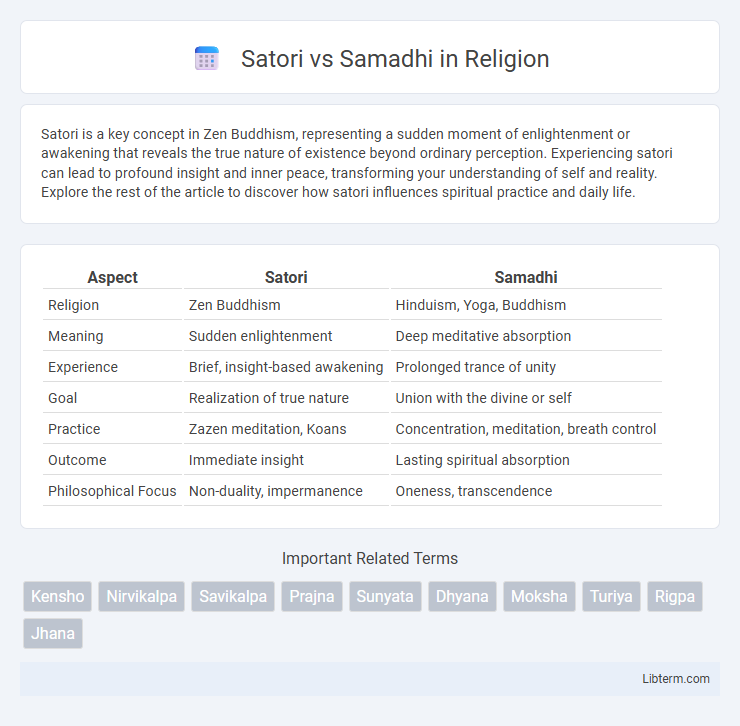Satori is a key concept in Zen Buddhism, representing a sudden moment of enlightenment or awakening that reveals the true nature of existence beyond ordinary perception. Experiencing satori can lead to profound insight and inner peace, transforming your understanding of self and reality. Explore the rest of the article to discover how satori influences spiritual practice and daily life.
Table of Comparison
| Aspect | Satori | Samadhi |
|---|---|---|
| Religion | Zen Buddhism | Hinduism, Yoga, Buddhism |
| Meaning | Sudden enlightenment | Deep meditative absorption |
| Experience | Brief, insight-based awakening | Prolonged trance of unity |
| Goal | Realization of true nature | Union with the divine or self |
| Practice | Zazen meditation, Koans | Concentration, meditation, breath control |
| Outcome | Immediate insight | Lasting spiritual absorption |
| Philosophical Focus | Non-duality, impermanence | Oneness, transcendence |
Understanding Satori and Samadhi: Definitions
Satori represents a sudden, brief awakening to one's true nature in Zen Buddhism, characterized by an intuitive realization that transcends ordinary understanding. Samadhi, found in various Hindu and Buddhist traditions, describes a deep, sustained state of meditative absorption where the mind attains complete stillness and unity with the object of focus. Both terms denote profound spiritual experiences, with Satori emphasizing instantaneous insight and Samadhi highlighting prolonged, focused concentration.
Historical Origins: Satori in Zen, Samadhi in Hinduism and Buddhism
Satori, rooted in Zen Buddhism, emerged in Japan as an experience of sudden enlightenment or awakening, emphasizing direct insight into one's true nature. Samadhi, originating from ancient Hindu scriptures and later integrated into Buddhist practice, denotes a deep meditative absorption where the mind attains profound concentration and unity. Both concepts highlight the transformative states on the spiritual path but diverge in cultural and doctrinal contexts, with Satori focusing on instantaneous realization and Samadhi on sustained meditative trance.
Core Philosophical Differences
Satori in Zen Buddhism represents a sudden awakening or glimpse of enlightenment, emphasizing direct, intuitive insight into the nature of reality without reliance on conceptual thought. Samadhi, a fundamental concept in Hinduism and other Indian spiritual traditions, denotes a deep, meditative absorption or trance state where the mind becomes fully focused and unified with the object of meditation, leading to profound inner stillness. The core philosophical difference lies in Satori's spontaneous, experiential realization contrasting with Samadhi's gradual, disciplined cultivation of concentrated awareness.
The Role of Mindfulness in Satori and Samadhi
Mindfulness plays a crucial role in both Satori and Samadhi by cultivating present-moment awareness that leads to profound spiritual experiences. In Satori, mindfulness acts as a catalyst for sudden enlightenment, enabling a direct and intuitive grasp of reality beyond conceptual thought. During Samadhi, sustained mindfulness supports deep meditative absorption, fostering an extended state of unity and tranquility where the mind transcends egoic limitations.
Pathways to Attaining Satori
Satori, a sudden awakening in Zen Buddhism, is often achieved through rigorous practices such as zazen (seated meditation), koan study, and mindfulness during daily activities. These methods aim to disrupt conventional thinking patterns, facilitating an immediate realization of one's true nature. Samadhi, by contrast, is attained through sustained concentration and deep meditative absorption, often cultivated in stages within various yogic or Buddhist traditions, emphasizing gradual refinement of focus and tranquility.
Practices Leading to Samadhi
Practices leading to Samadhi include deep meditation techniques such as concentration (dharana) and mindfulness (dhyana), often cultivated through yoga and disciplined mental focus. Unlike Satori, which is a sudden experience of enlightenment in Zen Buddhism, Samadhi entails sustained absorption characterized by the complete integration of the subject and object, often achieved through prolonged practice and spiritual discipline. Key methods involve breath control (pranayama), mantra repetition, and ethical living to prepare the mind for the heightened state of Samadhi.
Key Experiences: Temporary vs. Sustained Enlightenment
Satori represents a sudden, temporary glimpse of enlightenment often characterized by an intense but brief insight or awakening. In contrast, Samadhi refers to a sustained state of deep meditative absorption and continuous, stable enlightenment where the practitioner's mind remains profoundly unified and calm. While Satori offers fleeting moments that can inspire further spiritual practice, Samadhi embodies enduring realization and integration of enlightened consciousness.
Cultural Interpretations and Misconceptions
Satori and Samadhi, rooted in Zen Buddhism and Hindu traditions respectively, are often misunderstood as identical states of enlightenment, but cultural contexts reveal distinct interpretations; Satori emphasizes sudden, intuitive awakening, while Samadhi involves deep, meditative absorption and union with the divine. Misconceptions arise when Western interpretations conflate Satori's momentary insight with Samadhi's prolonged trance-like state, overlooking their unique spiritual objectives and practices. Understanding these differences is essential for appreciating the diverse pathways toward enlightenment in Eastern philosophies.
Modern Relevance and Applications
Satori and Samadhi represent distinct states of awakened consciousness crucial to Zen Buddhism and Hindu meditation, respectively, with modern relevance in mental health and mindfulness practices. Satori, characterized by sudden insight or enlightenment, is applied in cognitive therapy to foster breakthrough moments and enhance self-awareness. Samadhi, a deep meditative absorption, is utilized in stress reduction and neuroplasticity research, promoting sustained focus and emotional regulation in contemporary wellness programs.
Integrating Satori and Samadhi in Daily Life
Integrating Satori and Samadhi in daily life enhances both spontaneous insight and deep meditative absorption, creating a balanced spiritual practice. Satori offers sudden moments of awakening that can inspire mindfulness, while Samadhi cultivates sustained concentration necessary for profound inner peace. Practitioners benefit by grounding spontaneous enlightenment experiences with disciplined meditation, fostering continuous growth and clarity.
Satori Infographic

 libterm.com
libterm.com